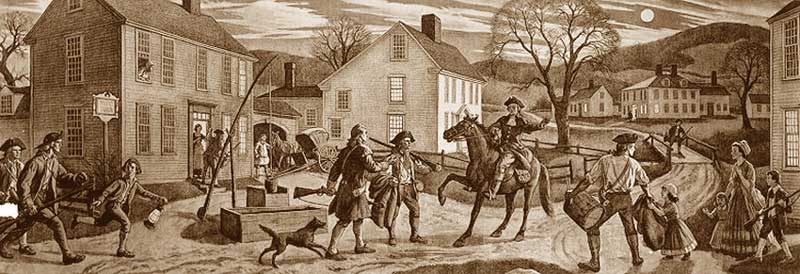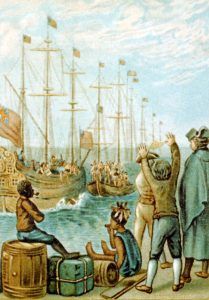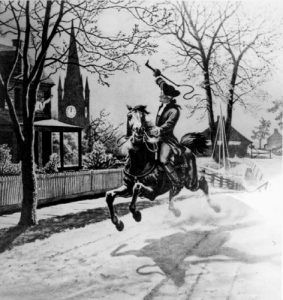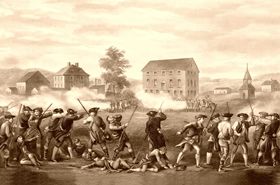Listen, my children, and you shall hear
Of the midnight ride of Paul Revere,
On the eighteenth of April, in Seventy-five;
Hardly a man is now alive
Who remembers that famous day and year.
— Henry Wadsworth Longfellow, 1861
~~
Paul Revere is an American folk hero of the American Revolution whose dramatic horseback ride on the night of April 18, 1775, warned Boston area residents that the British were coming.
Revere was born on December 21, 1734, in Boston, Massachusetts to Paul Revere, Sr, and Deborah Hitchbourn Revere. He was their third child and eldest surviving son. Paul was educated at the North Writing School and received sufficient education to enable him later to read the difficult metallurgical books of his period. His father was a silversmith and taught his craft to his son when Paul left school at the age of 13 to become his apprentice.
When Paul was 19 years old and nearly finished with his apprenticeship, his father died, leaving Paul as the family’s main source of income. Two years later, in February 1756, Revere was commissioned as a second lieutenant in the Massachusetts Artillery and sent to fight in the French and Indian War in upstate New York. When he returned in the Fall of 1756, he began to build the family silver business.
In August 1757, he married Sarah Orne, and the couple would eventually have eight children. Sarah died in 1773 from complications of giving birth to her eighth child.
Soon after Sarah’s death, Revere married Rachel Walker, with whom he also had eight children. Sadly, because of such high mortality rates in the colonial period, only six of Sarah’s children and five of Rachel’s children survived into maturity.
To support his growing family, Paul not only made silver articles ranging from simple spoons to magnificent tea sets but also crafted surgical instruments and spectacles, replaced missing teeth, and engraved copper plates. To supplement his income, he also produced illustrations for books and magazines, business cards, political cartoons, and other needs, as well as practicing as a dentist from 1768 to 1775.
In the 1770s, Revere enthusiastically supported the patriot cause, and in 1773 he donned Indian garb and joined 50 other patriots in the Boston Tea Party protest. He also served for years as the principal rider for Boston’s Committee of Safety, making journeys to New York and Philadelphia, Pennsylvania, in its service. He also helped organize an intelligence and alarm system to watch the British military.
By the time he made his famous midnight ride, Revere was 41 years old, owned his own home on North Square, and his silversmith business, located just a short distance away on the North End waterfront, was prosperous.
At 10:00 pm on the night of April 18, 1775, Revere received instructions from activist Dr. Joseph Warren to ride to Lexington, Massachusetts, to warn John Hancock, Samuel Adams, and the colonial militia that the British were approaching. He warned Hancock and Adams of their potential arrest and urged the patriots to move their military stores.
Both he and another rider named William Dawes reached Lexington separately, and both delivered the warning. Afterward, the pair along with a man named Samuel Prescott then started for Concord to give the warning, but they were soon stopped by a British patrol. Only Prescott got through. Revere was soon released by the British and returned to Lexington on foot. Because of Revere’s and the others’ warnings, the Minutemen were ready the next morning in Lexington to fight the battle that launched the American Revolution.
Following the Battles of Lexington and Concord, Revere printed paper currency for the Massachusetts government and constructed a much-needed powder mill to supply colonial arms.
In 1776, he served as a lieutenant colonel in the Massachusetts State Train of Artillery and put in command of Castle Island in Boston Harbor. During this time, he and his troops saw little action, and his military service ended with the failed Penobscot expedition in 1779.
When the war was over, he returned to his silversmith trade and expanded into industrial works, iron casting, bronze bell and cannon casting, and the forging of copper bolts and spikes. In 1800, he set up a rolling mill to manufacture sheet copper at Canton, Massachusetts, which was used as sheathing on naval vessels and the dome of the Massachusetts statehouse.
In 1811, at the age of 76, Paul Revere retired and left his well-established copper business in the hands of his son Joseph Warren Revere and two of his grandsons. He died of natural causes on May 10, 1818, at the age of 83, leaving five children, several grandchildren, and many great-grandchildren. He was laid to rest at Boston’s Granary Burying Ground.
“Seldom has the tomb closed upon a life so honorable and useful.”
— Boston Intelligencer
The home that Revere owned at the time of his ride still stands in Boston at 19 North Square as serves as a museum today.
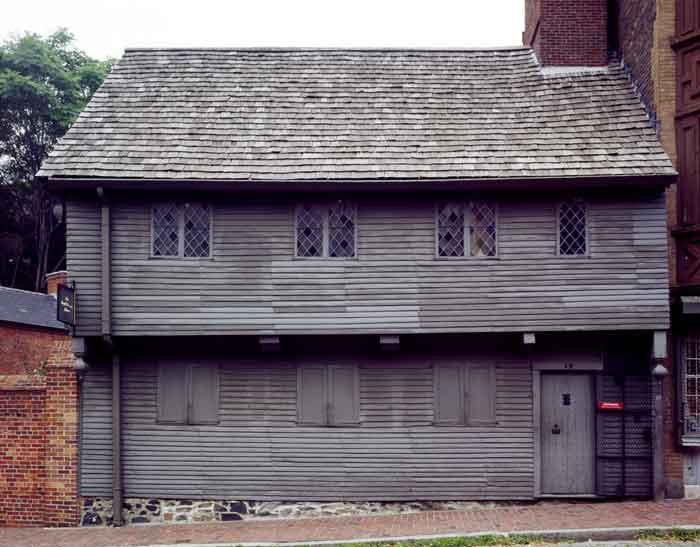
Paul Revere’s house, which the silversmith bought in 1770 when the building was already almost a century old. The overhang, or “jetty,” typifies the frame construction of the period. Photo by Carol Highsmith.
More than 40 years after his death, Henry Wadsworth Longfellow wrote his poem “Paul Revere’s Ride,” in 1860. Though there were many other riders that night spreading the general alarm, Longfellow’s poem made Revere into a national folk hero.
Listen, my children, and you shall hear
Of the midnight ride of Paul Revere,
On the eighteenth of April, in Seventy-Five:
Hardly a man is now alive
Who remembers that famous day and year.
He said to his friend, “If the British march
By land or sea from the town to-night,
Hang a lantern aloft in the belfry-arch
Of the North-Church-tower, as a signal-light,–
One if by land, and two if by sea;
And I on the opposite shore will be,
Ready to ride and spread the alarm
Through every Middlesex village and farm,
For the country-folk to be up and to arm.”
Then he said “Good night!” and with muffled oar
Silently rowed to the Charlestown shore,
Just as the moon rose over the bay,
Where swinging wide at her moorings lay
The Somerset, British man-of-war:
A phantom ship, with each mast and spar
Across the moon, like a prison-bar,
And a huge black hulk, that was magnified
By its own reflection in the tide.
Meanwhile, his friend, through alley and street
Wanders and watches with eager ears,
Till in the silence around him he hears
The muster of men at the barrack door,
The sound of arms, and the tramp of feet,
And the measured tread of the grenadiers
Marching down to their boats on the shore.
Then he climbed to the tower of the church,
Up the wooden stairs, with stealthy tread,
To the belfry-chamber overhead,
And startled the pigeons from their perch
On the sombre rafters, that round him made
Masses and moving shapes of shade,–
By the trembling ladder, steep and tall,
To the highest window in the wall,
Where he paused to listen and look down
A moment on the roofs of the town,
And the moonlight flowing over all.
Beneath, in the churchyard, lay the dead,
In their night-encampment on the hill,
Wrapped in silence so deep and still
That he could hear, like a sentinel’s tread,
The watchful night-wind, as it went
Creeping along from tent to tent,
And seeming to whisper, “All is well!”
A moment only he feels the spell
Of the place and the hour, and the secret dread
Of the lonely belfry and the dead;
For suddenly all his thoughts are bent
On a shadowy something far away,
Where the river widens to meet the bay, —
A line of black, that bends and floats
On the rising tide, like a bridge of boats.
Meanwhile, impatient to mount and ride,
Booted and spurred, with a heavy stride,
On the opposite shore walked Paul Revere.
Now he patted his horse’s side,
Now gazed on the landscape far and near,
Then impetuous stamped the earth,
And turned and tightened his saddle-girth;
But mostly he watched with eager search
The belfry-tower of the old North Church,
As it rose above the graves on the hill,
Lonely and spectral and sombre and still.
And lo! as he looks, on the belfry’s height,
A glimmer, and then a gleam of light!
He springs to the saddle, the bridle he turns,
But lingers and gazes, till full on his sight
A second lamp in the belfry burns!
A hurry of hoofs in a village-street,
A shape in the moonlight, a bulk in the dark,
And beneath from the pebbles, in passing, a spark
Struck out by a steed that flies fearless and fleet:
That was all! And yet, through the gloom and the light,
The fate of a nation was riding that night;
And the spark struck out by that steed, in his flight,
Kindled the land into flame with its heat.
He has left the village and mounted the steep,
And beneath him, tranquil and broad and deep,
Is the Mystic, meeting the ocean tides;
And under the alders, that skirt its edge,
Now soft on the sand, now loud on the ledge,
Is heard the tramp of his steed as he rides.
It was twelve by the village clock
When he crossed the bridge into Medford town.
He heard the crowing of the cock,
And the barking of the farmer’s dog,
And felt the damp of the river-fog,
That rises when the sun goes down.
It was one by the village clock,
When he galloped into Lexington.
He saw the gilded weathercock
Swim in the moonlight as he passed,
And the meeting-house windows, blank and bare,
Gaze at him with a spectral glare,
As if they already stood aghast
At the bloody work they would look upon.
It was two by the village clock,
When be came to the bridge in Concord town.
He heard the bleating of the flock,
And the twitter of birds among the trees,
And felt the breath of the morning breeze
Blowing over the meadows brown.
And one was safe and asleep in his bed
Who at the bridge would be first to fall,
Who that day would be lying dead,
Pierced by a British musket-ball.
You know the rest. In the books you have read,
How the British Regulars fired and fled,–
How the farmers gave them ball for ball,
From behind each fence and farmyard-wall,
Chasing the red-coats down the lane,
Then crossing the fields to emerge again
Under the trees at the turn of the road,
And only pausing to fire and load.
So through the night rode Paul Revere;
And so through the night went his cry of alarm
To every Middlesex village and farm,–
A cry of defiance, and not of fear,
A voice in the darkness, a knock at the door,
And a word that shall echo forevermore!
For, borne on the night-wind of the Past,
Through all our history, to the last,
In the hour of darkness and peril and need,
The people will waken and listen to hear
The hurrying hoof-beats of that steed,
And the midnight message of Paul Revere.
Henry Wadsworth Longfellow, 1860
© Kathy Alexander/Legends of America, updated October 2022.
Also See:
American Revolution Photo Gallery
Causes of the American Revolution
Sources:
Encyclopedia Britannica
National Park Service
Paul Revere House
Wikipedia

